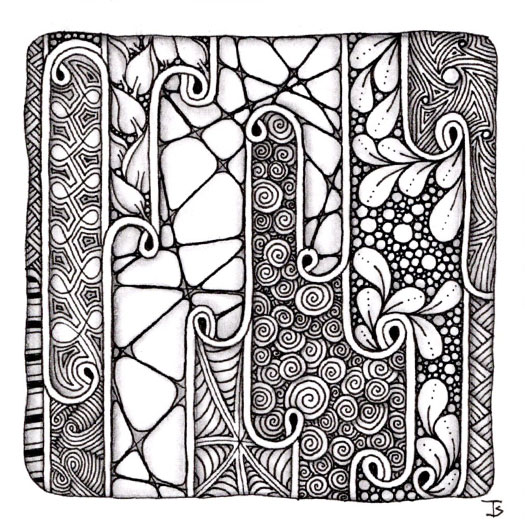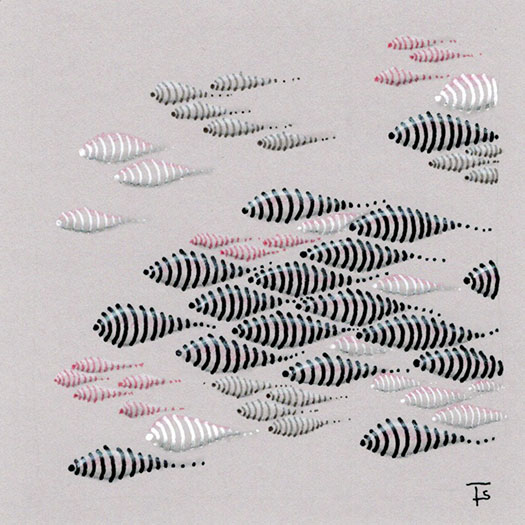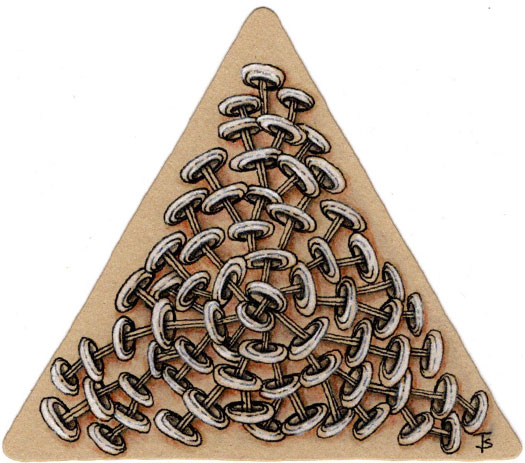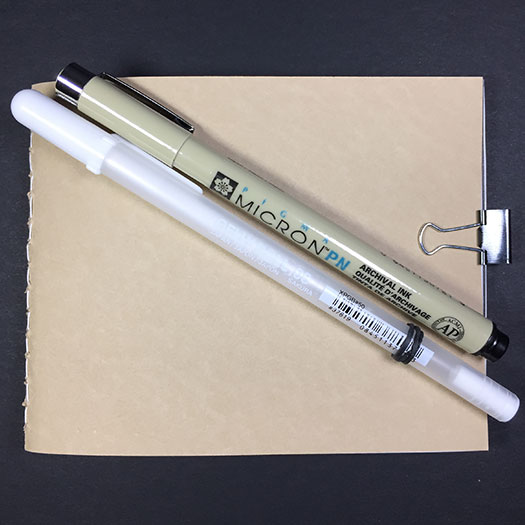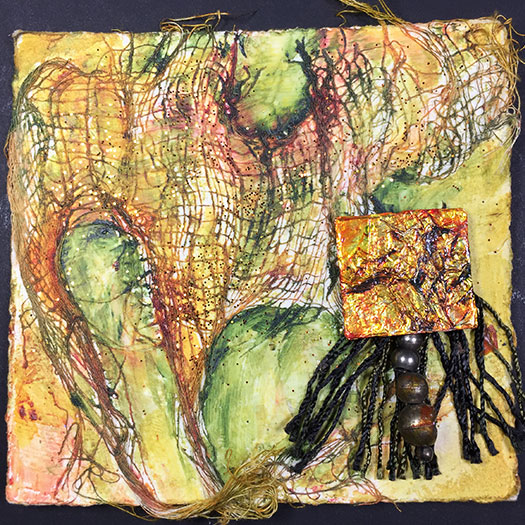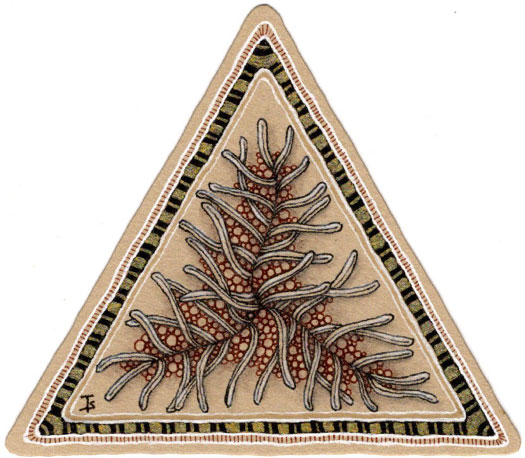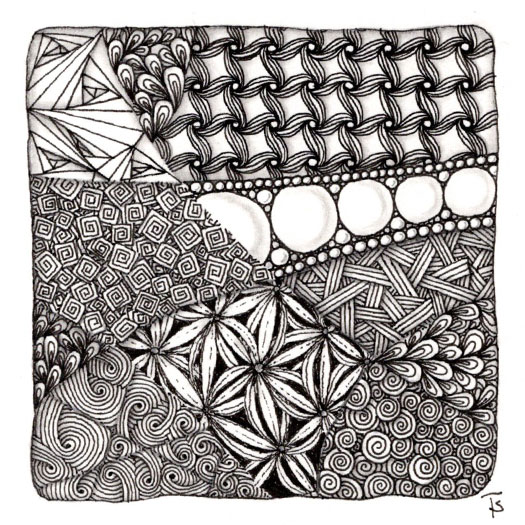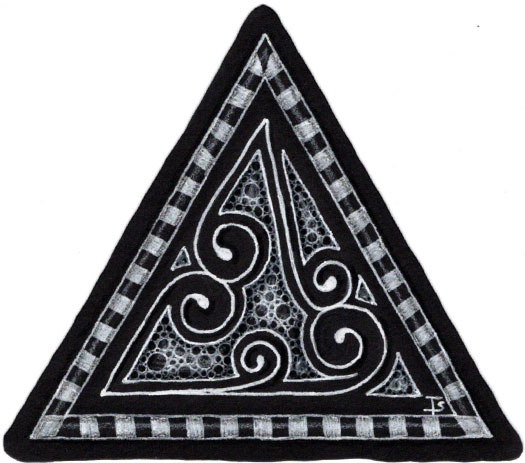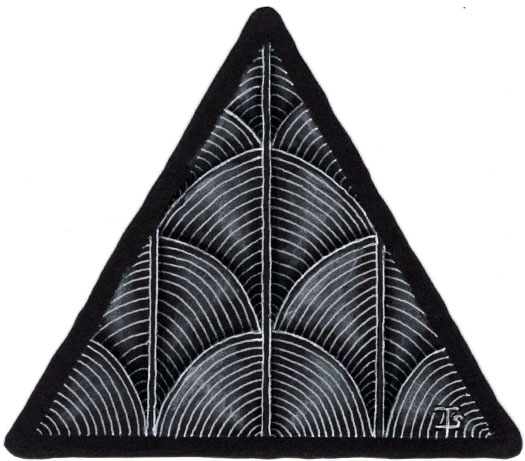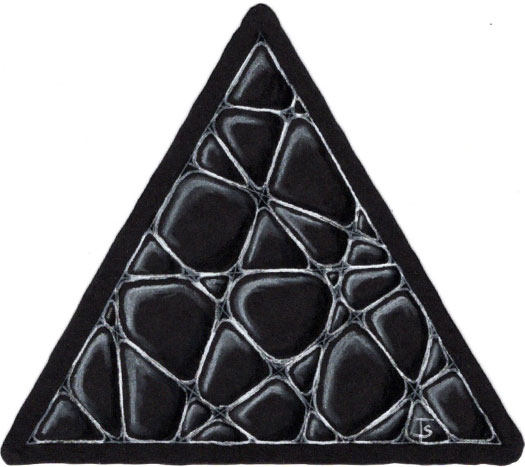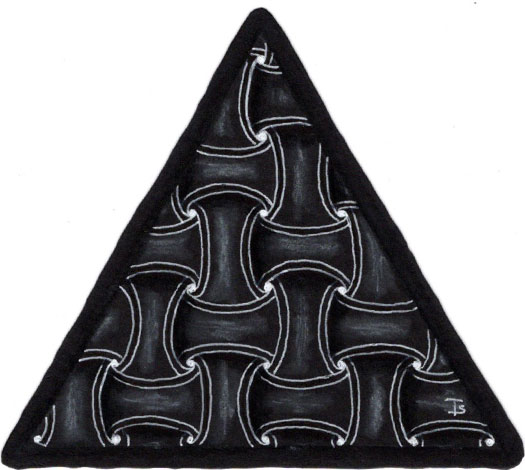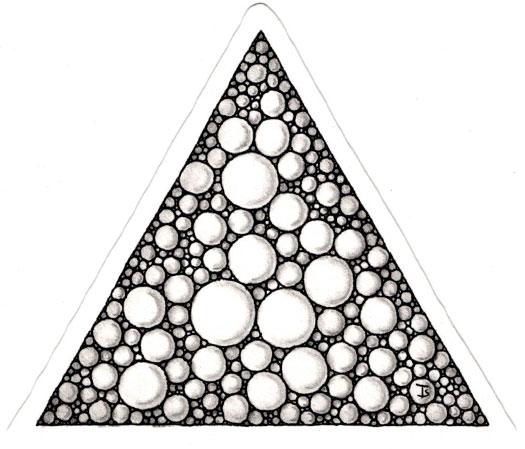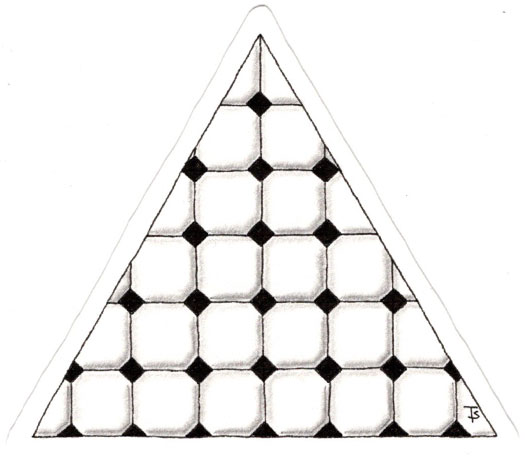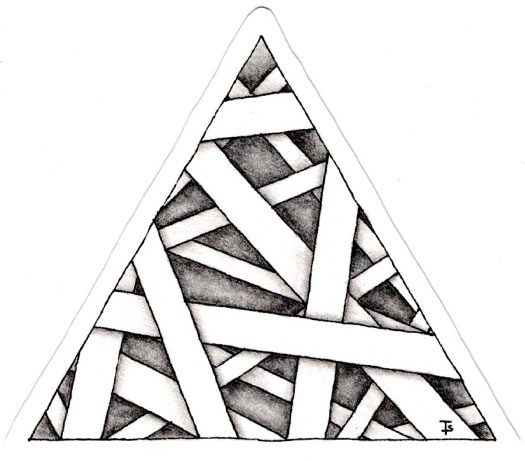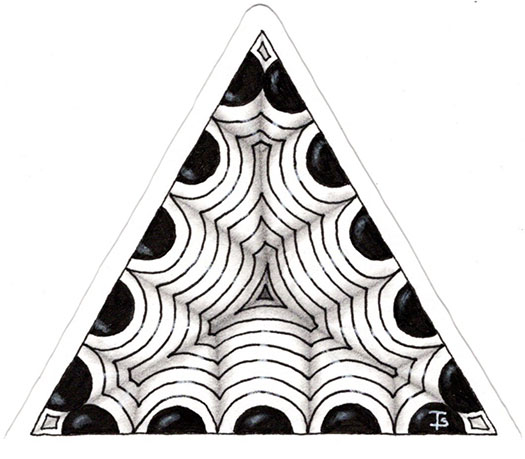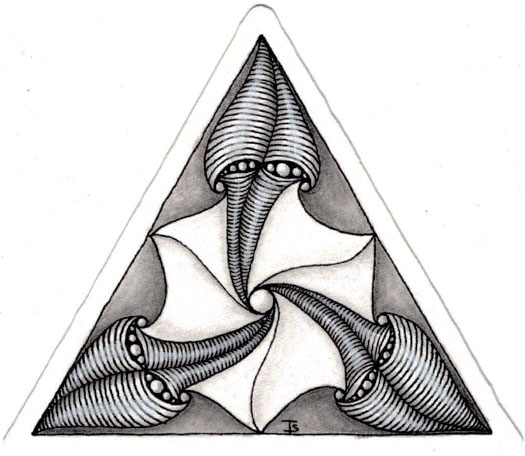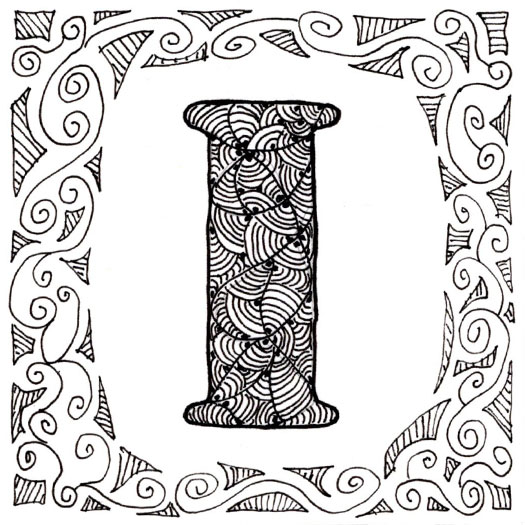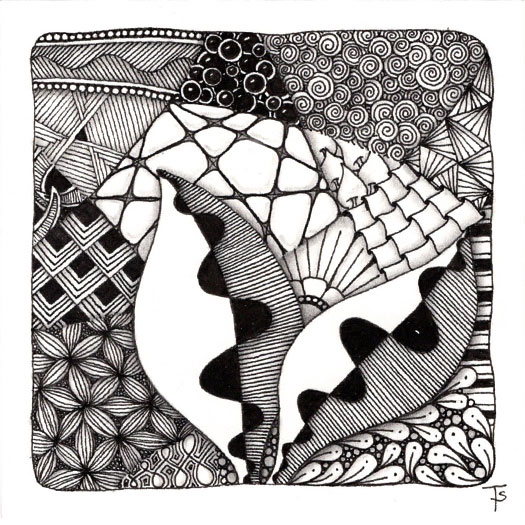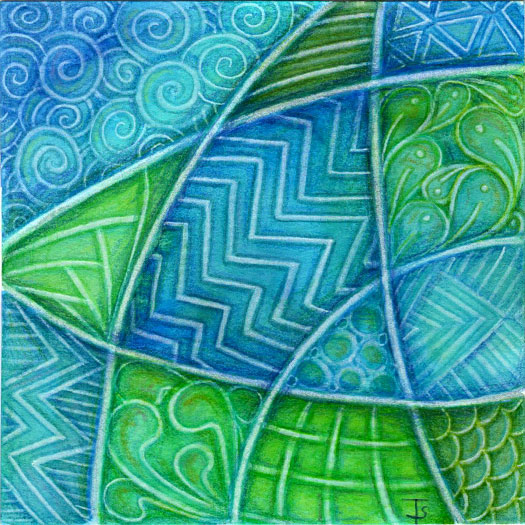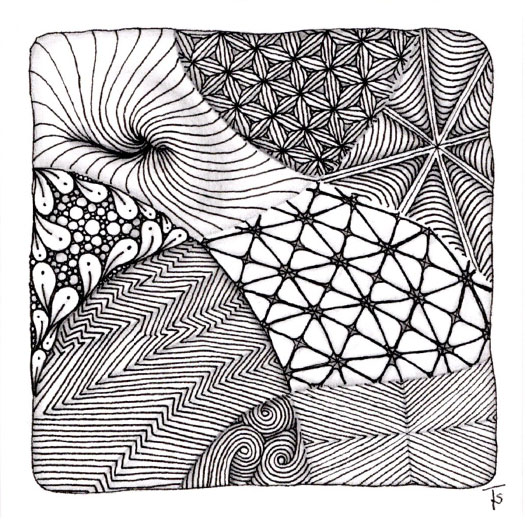Melting Mooka, introduced to us by Zentangle's Project Pack #6 , is a wonderful version of Mooka that can be used to as a string to divide a tile into smaller spaces.
These internal sections, when filled with other tangles, result in a tile that gives the impression of stained glass windows.
This was a fun, playful exercise!
Zentangle drawn on Strathmore Vellum Bristol using a black, Micron pen. Shading done with graphite pencil.
There is something very soothing about drawing this particular tangle. I’ve been playing with it all weekend.
For this tile, I thought it would be fun to create schools of tangled, fish-like shapes in different sizes to simulate depth and visual variety. I wanted to do a tile in pinks, greys, white and black for a while, and this seemed like the perfect opportunity!
Zentangle drawn on stone, Neena Naturals, using black, Pigma Micron, cool grey Copic Multiliner and pink Stablo finliner pens. Shading done with graphite and colored pencil. Highlights created with white Charcoal and colored pencils.
This the tangle on this 3Z monotangle is "Wheelz", by Joyce Block . If you click on the link, you can see her step-out for it. Just as any tangler, the way I draw it reflects my style, but you will see that mine is close to the original. It is similar to the tangle “Rixty”, by Zentangle.
I love the way this tangle kind of grows, as you draw it. Depending on where you choose to place each element, and how far apart the elements are, it can remind the viewer of a flower or a spiral or berries or seed pods! It’s a wonderful, organic fill, or can be used as a border or divider between other tangles.
I wanted to participate in Project Pack #6 from Zentangle, but I couldn’t purchase anything extra right now. However, after seeing what was in the kit, I decided to make my own small book!
The pages are made from Canson Multimedia paper. And the cover is made from Stonehenge Kraft paper. I thought it would be fun to tangle on the cover and the brown color should work nicely.
It’s interesting how things appear in our lives!
On Monday, I went to a Barnes and Noble Bookstore. As I got out of the car and made my way to the store, I looked down and saw a card on the ground. It was about 4 inches square, yellow around the edges, with writing on it. It also had a couple of stickers.
I didn’t think a lot about it, only slightly curious. I figured it was some trash someone threw away. I continued on into the store.
I love tangling on tan! It opens the door to so many different and interesting possiblities. And I never know how it will actually turn out.
This was inspired by another Zentangle that I did last year. But I wanted to change it up some, and recreate it on a triangular tile.
Although it didn’t show up well on the scan, I used gold ink on top of the black band on the border to create a Marasu pattern. And I used a brown pen to draw the Tipple bubbles around the central Verdigogh fronds.
I like to have a tile that has a complex string with a lot of different spaces. I can sit down and fill an area with a random tangle when I have a few moments. But I don’t have to work on it until it’s done. I just return to it when I have a short bit of time.
That means it may be sitting on my desk for a while before it’s finished!
I’ve posted Zentangles with a design similar to this tile before, here and here .
In addition, the other two examples have no shading or highlights. So I needed and example that included these additions.
I’m doing it again because I’m using it on a class project and I wanted it on a 3Z for my students to observe and discuss.
Zentangle drawn on black, Strathmore, Artagain paper using a white, Sakura, gel pen. Shading done with Copic Markers and black colored pencil. Highlighting done with General’s Charcoal White.
For me, this is the traditional way of drawing Shattuck. As an alternative, it could be done with straight lines, instead of curved. I do it both ways, depending on what I am working on.
Zentangle drawn on black, Strathmore, Artagain paper using a white, Sakura, gel pen. Shading done with Copic Markers and black colored pencil. Highlighting done with General’s Charcoal White.
Tangles: Shattuck
One of the things that I love about the “Crazy” versions of various tangles is how forgiving they are for those who struggle with perfection. Crazy ‘Nzeppel is a perfect example. Because each section ends up being a different, and some times surprising shape, each squished bubble doesn’t have to match any other!
Zentangle drawn on black, Strathmore, Artagain paper using a white, Sakura, gel pen. Shading done with Copic Markers and black colored pencil. Highlighting done with General’s Charcoal White.
Huggins is a favorite tangle for many, many people. Here, I’ve chosen to create it in a traditional manner, with added auras inside each shape.
When this was first drawn, it really didn’t look like much. But the addition of shading and highlighting brings it to life!
Zentangle drawn on black, Strathmore, Artagain paper using a white, Sakura, gel pen. Shading done with Copic Markers and black colored pencil. Highlighting done with General’s Charcoal White.
How do you practice drawing orbs? By drawing orbs!
I actually found it very relaxing to draw lots and lots of circles. I tried various methods, both drawing all the way around in one fluid motion and drawing a “C” shape for one side and then the other.
I learned that some sizes I can do very nicely, and some are harder to do. It’s important to turn the tile so that you can see what your doing. It made a big difference!
This deceptively simple tile was so meditative because I took my time with the linework.
A great trick to use, to get the spacing even is to “divide and conquer.” What I mean by that is to begin by dividing the space in half, vertically. Then divide each half in half again. Repeat until you are happy with the divisions.
Then divide the horizontal spaces. In the case of this tangle, they are equal to the width of the vertical divisions, making a square. Or there about.
Back to basics! I have never done a monotangle of Crescent Moon. I decided to tackle it yesterday on a 3Z-type tile, just to see what would happen.
Here’s the result!
Zentangle drawn on Stonehenge white using a black, Micron pen. Shading done with graphite and colored pencil. Highlights created with a white, charcoal pencil.
Tangles: Crescent Moon
I wanted to try this medallion-style tangle on a 3Z tile for a while now. I like the way it turned out, even though shading was a bit of a challenge. I ended up using some black colored pencil in the background areas to increase the contrast. I think that created a a very interesting look.
For even more contrast, I added a bit of white, charcoal pencil to create some highlights.
I wrote a bit about my Mother-in-law a while back. Today, as I was going through her stuff, I found a plastic box full of tiles. Inside were pre-cut blank tiles, completed Zentangles and a full set of tiles representing each letter of the alphabet.
Apparently, she use letter stencils to create the letter in the center and then used tangles who’s name begins with the same letter to decorate the tile.
Generally, now days, I use fewer tangles on a tile that I did when I began 10 years ago. But not always.
Yesterday, I decided to create a complex string and use a lot of different tangles. I had been looking through tiles from years ago and I wanted to see if I could still tangle in that style.
It took longer to choose the tangles than it did to draw them! 17 tangles is a LOT!
This tile was created following the instructions from Eni Oken ’s Art Club ’s latest lesson, Glazed Whitework .
It all started with a watercolor tile. It was an interesting challenge to draw the string and all of the tangles using a white colored pencil. Then more color was added creating the depth and shading you see here.
One of the most challenging things was to select appropriate tangles. It’s much more difficult to create detail with colored pencils than if you were using an inking pen.
My random tanglizer spit out a lot of tangles for practicing line work yesterday. At first, I was a bit worried that these wouldn’t produce enough contrast. But after using my magic wand (actually, a pencil), I like the way they became distinct and unique!
Zentangle drawn on Strathmore Vellum Bristol using a black, Micron pen. Shading done with graphite pencil.
Tangles: Fassett Flux Fracas Nzepple Sand Swirl Static Tipple Xircus
